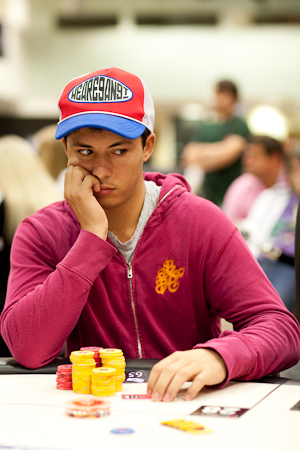|
|

Semi-Bluff - To bet a draw as if it were a made hand.
In a poker game, players will try to use deception to try to improve their chances of winning. Two related but fundamentally different
methods of deceiving your opponents are bluffing and
semi-bluffing. A bluff occurs when you bet or raise with a weak hand simply because you donít think your opponent will call. Since you
typically bluff with a bad hand or a busted draw, you realize that you will probably lose if you are called. This can make bluffing a
risky proposition, depending on how well you read your
opponent. In order for a bluff to be successful, you need to try it while your opponent is weak or on a draw which he fails to complete.
You should avoid trying to bluff your opponent when he has a strong hand.
A semi-bluff occurs when you bet or raise with an uncompleted drawing hand. Consider a situation where your opponent bets into you on
the turn. The board has two picture cards and
three babies, with two spades. You hold Ace-baby suited in spades and you believe that your opponent is weak or on a draw. Since you believe
that your opponent will not call, and because you are likely to win the pot if an Ace or a spade hit the river anyways, this would be a
good spot to semi-bluff and raise your opponent. Semi-bluffing here gives you three ways to win the pot. First, your opponent can fold in
the face of your raise, as you suspect he will. Second, you can complete your hand on the river and win at
showdown. Or finally, you can try another bluff on the river bet.
As you can imagine, semi-bluffing is a more valuable and more frequently used tool than straight bluffing. A semi-bluff is less risky
than a straight bluff, because even if you are called, you still have a chance to draw and to complete your hand. A good way to
approach the concepts of bluffing and semi-bluffing is to think about hand values, or more precisely, how hand values affect the
incentive to bluff or semi-bluff. Consider a situation where you have nothing of value in your hand, but you also put your opponent on
a very weak hand. Normally your hand would be worthless, but you have some information that gives it value. You feel your opponent is
weak and bluffable. You can extract the value by making the correct play, which is bluffing.
Of course, your bluffs do not have to be 100% successful in order to make them correct for a given situation. In fact, if your bluffs
do not fail at least half the time, you probably are not bluffing enough. In order for a bluff to be worthwhile, it has to be
successful enough to yield a return on the amount of money bluffed, which justifies the risk you took in bluffing. But remember, the
amount of the pot is often several multiples of the amount that you risk by bluffing. In other words, you can generally win more than
you risk when you bluff successfully. This is the main reason it makes sense to bluff frequently enough that your success rate drops
but not plummets. If your success rate is very high, you are probably being too cautious, and may be missing opportunities.
While bluffing is a useful and valuable tool to have in your tool kit, equally as useful and valuable is the art of semi-bluffing. The
main thing that separates a semi-bluff from a straight bluff is that when you semi-bluff, you also hold a draw, so that you still have
a chance to win the pot when your opponent calls your bet or raise. This seems like a simple difference, but the impact of this on
game play can be complex and multifaceted. The first and most obvious thing that you should realize about semi-bluffing is that having
a legitimate draw adds value to your hand. Understanding where the value lies is the key to extracting it.
Since your semi-bluffing hand has added value over a bluffing hand without a draw, you will be able to play in every bluffing
situation, plus many additional situations in which your bluffing power alone would not have been enough. This requires that you bet
aggressively into some more marginal bluffing situations which you would have avoided with a straight bluffing hand. Since betting
aggressively is often correct here, there is a huge incentive to attempt to employ deception, and to represent a hand that you do not
have, which can also add value to your hand. Since you are on a draw when you semi-bluff, the hand that you are attempting to represent is
often top pair or a set. If you can get your opponent to buy this, you can often win the pot whether or not you complete your draw.
Usage: On A Semi-Bluff, Semi-Bluff Raise
Previous Poker Term: Second Pair
Next Poker Term: Set |
|









